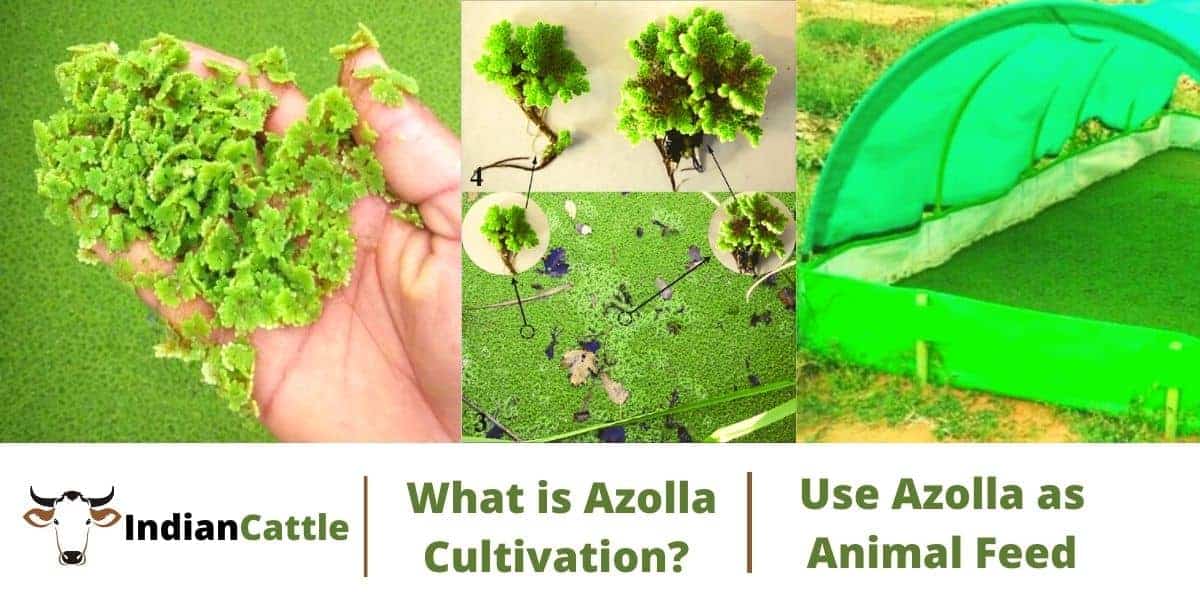
Production of Azolla for Livestock Feed
What is Azolla?
Azolla is a free-floating, rapidly growing aquatic fern on the water surface. Azolla cultivation helps the farmer to reduce the cost of Livestock Feed supplements and it is useful to feed supplements for livestock, poultry, and fish. It floats like a small, flat, compact green mass. Under ideal conditions, the Azolla plant grows exponentially, doubling its biomass every three days. There are at least eight species of Azolla worldwide; Azolla caroliniana, Azolla circinata, Azolla japonica, Azolla Mexicana, Azolla microphylla, Azolla nilotica, Azolla pinnata, and Azolla Rubra.
The common species of Azolla in India is Azolla pinnata. It produces more than 4 to 5 times of protein of excellent quality in comparison to lucerne and hybrid Napier. Besides this, biomass production is almost 4 to 10 times when compared with hybrid Napier and lucerne, respectively. These two parameters are very important to enhance economic livestock production to establish that Azolla is reckoned as “The Super Plant”.
Despite being the largest producer of milk, in India, there is an acute shortage of feed and fodder for dairy animals. Shortage of dry fodder, green fodder, and concentrate have been estimated to be 12 to 14 percent, 25 to 30 percent, and 30 to 35 percent, respectively. The shortage of fodder is, therefore, compensated with the use of readymade commercial feed resulting in increased cost of milk production. The search for alternatives to green fodder and concentrates led to the wonderful plant Azolla, which holds the promise of providing sustainable feed for livestock.
Azolla is a free-floating water fern. It is a common Azolla biofertilizer in rice crops. The blue-green algae (Anabaena Azolla) grow in symbiotic association with this fern and are responsible for nitrogen fixation. Among different species of the genus Azolla, Azolla pinnata is popular. The higher crude protein content (above 20 %) and presence of essential amino acids (high lysine content) vitamins like A& B and minerals like calcium, phosphorous, 12 potassium, and magnesium made Azolla a useful feed supplement for livestock, poultry, and fish.
Requirements for Growth
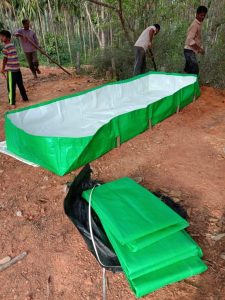
Azolla is naturally found in ponds, ditches, and wetlands of warm temperate and tropical regions throughout the world. It requires light for photosynthesis and grows well in partial shade (Azolla bed for Azolla cultivation/). Generally, Azolla needs 25 to 50 percent of full sunlight for its normal growth. Water is the basic requirement for the growth and multiplication of Azolla and is extremely sensitive to lack of water. Maintenance of an adequate water level (at least 4 inches in the pond) is essential.
The species vary in their requirements of ideal temperature. In general, the 0 0 0 optimum is 20 C to 30 C. Temperatures above 37 C will seriously affect the multiplication of Azolla. The optimum relative humidity is 85 to 90 percent. The optimum pH is 5 to 7. Too acidic or alkaline pH has an adverse effect on this fern. Azolla absorbs the nutrients from the water. Though all elements are essential, phosphorus is the most common limiting element for its growth. About 20 ppm of phosphorus in the water is optimum. Micronutrient application improves multiplication and growth.
How to cultivate Azolla? (Azolla Cultivation)
For the Azolla cultivation, a shallow freshwater pond is ideal. The detailed procedure for the production of Azolla is explained below:-
Maintenance of the Pond
Application of about one kg of cow dung and about 100 grams of superphosphate once in two weeks will ensure better growth of Azolla. Any litter or aquatic weeds are seen in the pond should be removed regularly. The pond needs to be emptied once in six months and cultivation has to be restarted with fresh Azolla culture and soil.
Azolla Production
Sieved fertile soil mixed with cow dung and water needs to be spread uniformly in the pond. About one kilogram of fresh Azolla culture is needed for a pond of 6 X 4 feet size. It has to be applied uniformly in the pond. Biogas slurry can also be used instead of dung. The depth of water should be four to six inches. During the monsoon season, if rainwater can be harvested from the rooftops and used for Azolla cultivation, it will ensure excellent and faster growth of Azolla. A few farmers used this practice in the project area (Chitradurga district of Karnataka) and got encouraging results. If the total salt content of the water used for growing Azolla is high, it will adversely affect the growth.
Selection of Location for the Pond
It is better to select an area near the house to ensure regular upkeep and monitoring of the pond. A suitable water source should be nearby for a regular water supply. The site under partial shade is ideal or else, shade has to be created to reduce the evaporation of water and also, for better growth of Azolla. The floor area of the pond should be free of pointed stones, roots, and thorns that can puncture the sheet and cause leakage of water.
Pond Size and Construction
The size of the pond depends on factors like the number of animals, the quantity of supplemental feed required, and the availability of resources. For smallholders, an area of 6 X 4 feet for Azolla cultivation can produce about one kg of supplemental feed per day. The selected area should be cleaned and leveled. The sidewalls of the pond can be of either brick or raised embankment with the excavated soil. After spreading the durable plastic sheet (s in the pond, all the sides have to be secured properly by placing bricks over the side walls.
After the inoculation of culture, the pond needs to be covered with a net to provide partial shade and also, to prevent the fall of leaves and other debris into the pond. Thin wooden poles or bamboo sticks are to be placed over the pond walls to support the shade net. Bricks or stones can be used as weights on the edges for securing the plastic sheet and also, the net over the pond area.
Harvesting and Feeding of Azolla
Depending on the initial quantity of culture added, environmental conditions, and nutrition, Azolla’s growth in the pond will be completed in about two to three weeks. It can be harvested daily after full growth. Plastic sieves can be used to harvest the biomass from the pond’s surface. About 800 to 900 grams of fresh Azolla (mean yield per day in a season) can be produced from an area of 6 X 4 feet. Azolla can be fed to the livestock either in fresh or dried form. It can be given directly or mixed with concentrates to cattle, poultry, sheep, goat, pigs, and rabbits.
In the studies with over 100 dairy farmers done at various villages of Chitradurga district of Karnataka under the NAIP livelihood project, feeding of Azolla @ 800 grams (fresh weight) on an average per day, improved the monthly milk yield by at least 10 liters per cow. It takes a few days for the animals to get used to the taste of Azolla. So, it is better to feed it along with the concentrates in the initial stages. Azolla has to be washed thoroughly with fresh water to remove the smell of dung.
Economics
The expenditure on preparing a 6 X 4 feet pond is minimal at Rs.500 (sheet plus labor cost). A farmer can realize a net profit of over Rs. 4000 per annum from the additional milk yield and reduced usage of concentrates’ feeding for livestock.
Limitations
As the dry matter content is only about 7 percent, it is difficult to rely solely on Azolla as the feed resource. Environmental constraints like very high (summer in dry areas) or low (winters in North India) temperatures, low humidity, limited water availability and poor quality of water makes it difficult to adopt Azolla’s production.
Precautions for Azolla Cultivation
- A shady place, preferably under a tree, with sufficient sunlight should be chosen for the Azolla production unit. A place of direct sunlight should be avoided.
- All corners of the pit should be of the same level so that the water level can be maintained uniformly.
- Azolla biomass @ 300 gms – 350 gms/sq.meter should be removed daily to avoid overcrowding and for keeping the fern at the rapid multiplication phase.
- Suitable nutrients should be supplied, as and when the nutrient deficiency is noticed.
- Plant protection measures against pests and diseases should be taken as and when required,
- About 5 kg of bed soil should be replaced with fresh soil, once in 30 days, to avoid nitrogen build-up and prevent micro-nutrient deficiency.
- 25 to 30% water is also needed to be replaced with freshwater, once in 10 days, to prevent nitrogen buildup in the bed.
- Replacement of water and soil should be followed by fresh inoculation of Azolla, at least once in six months.
- A fresh bed has to be prepared and inoculated with a pure culture of Azolla when contaminated by pests and diseases.
Livestock Feed
Azolla has enormous potential as a livestock feed due to its:
- high content in proteins, essential amino acids, vitamins (vitamin A, vitamin B12, Beta Carotene), growth promoter intermediaries, and minerals.
- ability to proliferate without inorganic nitrogen fertilization.
- high rate of growth in water without the need to displace existing crops or natural ecological systems.
It has been used for many years throughout Asia and parts of Africa to feed pigs, ducks, chickens, cattle, fish, sheep and goats, and rabbits.
Suitability of Azolla as Animal Feed
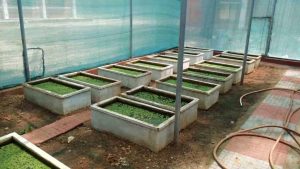
Green plants have long been recognized as the cheapest and most abundant potential source of proteins because of their ability to synthesize amino acids from a wide range of virtually unlimited and readily available primary materials. Azolla is very rich in proteins, essential amino acids, vitamins (vitamin A, vitamin B12, Beta Carotene), growth promoter intermediaries, and minerals including calcium, phosphorous, potassium, ferrous, copper, magnesium. On a dry weight basis, Azollahas 25-35% protein content, 10-15% mineral content, and 7-10% comprising a combination of amino acids, bio-active substances, and biopolymers. Azolla’s carbohydrate and oil content are very low.
Azolla is also rich in iron (1000–8600 ppm dry weight), copper (3–210 ppm dry weight) manganese (120–2700 ppm dry weight), vitamin A (300–600 ppm dry weight.), vitamin A (300–600 ppm dry weigh), chlorophyll and carotenoids. It contains 4.8–6.7% dry weight crude fat, with 6.1–7.7% and 12.8– 26.4% total fat for the polyunsaturated acids omega 3 and omega 6 (Paoletti et al., 1987). Azolla meal contains 25.78% crude protein, 15.71% crude fiber, 3.47% ether extract, 15.76% ash, and 30.08% nitrogen-free extract on an air-dry basis (Basak et al., 2002). In addition, aquatic plant species including Azolla do not accumulate secondary plant compounds and therefore have a greater potential than tree leaves to source protein for monogastric animals.
Azolla is the most promising aquatic plant for livestock feed due to its ease of Azolla cultivation, productivity, and nutritive value. Uses of Azolla as a feed for fish, swine, and poultry were also tested and recommended that one hectare of Azolla can produce 540-720 kg of protein per month.
Azolla’s composition, therefore, makes it one of the most economical and efficient feed substitutes for livestock, particularly as it can be easily digested by livestock due to its high protein and low lignin content.
Cattle and Milk Production
Fodder is an important requirement for cattle. Even if the animals are fed with commercial feeds from the market, fresh green grass or dry straw is essential as fodder availability greatly reduces the expenditure on commercial feeds. The success of a dairy plant depends largely on increasing milk production without an escalation in feeding costs. Growing fodder grass is a good option. Another is Azolla cultivation.
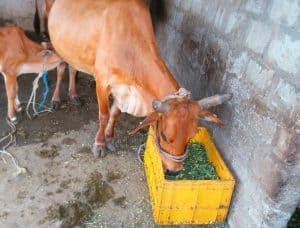
Although the demand for milk and meat has increased in countries such as India, there has also been a substantial decline in fodder production owing to the decreasing forest and grassland areas. The fodder availability from various crops has also decreased largely due to the introduction of high-yielding dwarf varieties. Shortages of fodder are therefore being compensated with commercial feed, resulting in increased cost of meat and milk production. Moreover, as commercial feed is mixed with urea and other artificial milk boosters, it has a deleterious effect on the quality of milk produced and the longevity of the livestock, which in turn leads to degenerative diseases like cancer and coronary ailments in human beings.
Azolla Cultivation for Livestock Feed
Several cost-effective methods can be used for Azolla cultivation. The one described here was developed by India’s Natural Resources Development Project (NARDEP).
NARDEP’s Azolla Cultivation Method
Nardep, therefore, developed a method for Azolla cultivation that is easy and economical for livestock farmers. One of its attractions is that the dung produced by livestock is used to help fertilize the Azolla plants which, in turn, provide nutrition for the livestock.
- A water body is made, preferably under the shade of a tree, with the help of a silpaulin sheet. Silpaulin is a polythene tarpaulin that is resistant to ultraviolet radiation in sunlight. A pit of 2 x 2 x 0.2 m is dug as a first step.
- All corners of the pit should be at the same level so that a uniform water level can be maintained. The pit is covered with plastic gunnies to prevent the roots of the nearby trees from piercing the silpaulin sheet, which is spread over the plastic gunnies.
- About 10 – 15 kg of sieved fertile soil is uniformly spread over the silpaulin sheet. Slurry made of 2 kg cow dung and 30 g of Super Phosphate mixed in 10 liters of water, is poured onto the sheet. More water is poured on to raise the water level to about 10 cm.
- About 0.5 – 1 kg of a fresh and pure culture of Azolla is placed in the water. This will grow rapidly and fill the pit within 10 – 15 days. From then on, 500 – 600 g of Azolla can be harvested daily. A mixture of 20 g of Super Phosphate and about 1 kg of cow dung should be added once every 5 days in order to maintain the rapid multiplication of the Azolla and to maintain the daily yield of 500 g.
- A micronutrient mix containing magnesium, iron, copper, sulfur can also be added at weekly intervals to enhance the mineral content of Azolla.
Key Points of NARDEP’s Method of Azolla Production
- It is important to keep Azolla at the rapid multiplication growth phase with the minimum doubling time. Therefore biomass (around 200 g per square meter) should be removed every day or on alternate days to avoid overcrowding.
- Periodic application of cow-dung slurry, superphosphate, and other macro and micronutrients except for nitrogen, will keep the fern multiplying rapidly.
- The temperature should be kept below 25°C. If the temperature goes up the light intensity should be reduced by providing shade. If possible, it is best to place the production unit where it is shady.
- The pH should be tested periodically and should be maintained between 5.5 and 7.
- About 5 kg of bed soil should be replaced with fresh soil, once in 30 days, to avoid nitrogen build-up and prevent micro-nutrient deficiency.
- 25 to 30 percent of the water also needs to be replaced with freshwater, once every 10 days, to prevent nitrogen buildup in the bed.
- The bed should be cleaned, the water and soil replaced and new Azolla inoculated once every six months.
- A fresh bed has to be prepared and inoculated with a pure culture of Azolla when contaminated by pests and diseases.
- The Azolla should be washed in fresh water before use to remove the smell of cow dung.
Harvesting and Preparing Azolla as Livestock Feed
- Harvest the floating Azolla plants using a plastic tray having holes of 1 cm2 mesh size to drain the water.
- Wash the Azolla to get rid of the cow dung smell. Washing also helps in separating the small plants which drain out of the tray. The plants along with water in the bucket can be poured back into the original bed.
- For use as livestock feed, the fresh Azolla should be mixed with commercial feed in a 1:1 ratio to feed livestock. After a fortnight of feeding on Azolla mixed with concentrate, livestock may be fed with Azolla without added concentration.
- For poultry, Azolla can be fed to egg layers as well as broilers.
- In severe pest attacks, empty the entire bed and lay out a fresh bed in a different location.
Conclusion
Azolla can be used as an ideal feed substitute for cattle, fish, pigs, and poultry, apart from its utility Azolla as biofertilizer for wetland paddy. Azolla cultivation helps the farmer to reduce the cost of the Livestock Feed supplement. Azolla technology will be taken up in a big way by the dairy farmers, especially, by those who experience land-scarce conditions for fodder production.
Available Products in the Market:
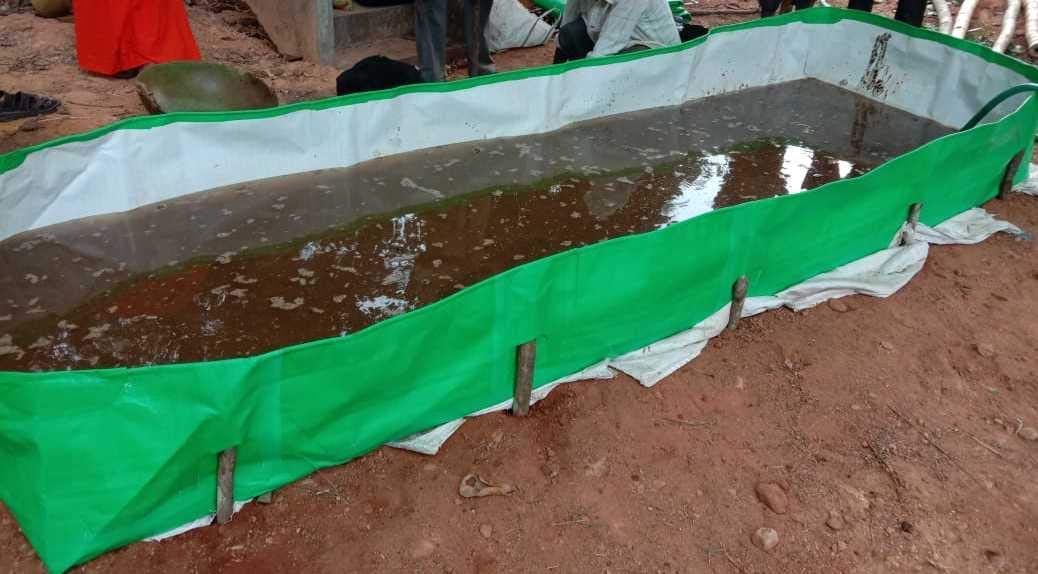 |
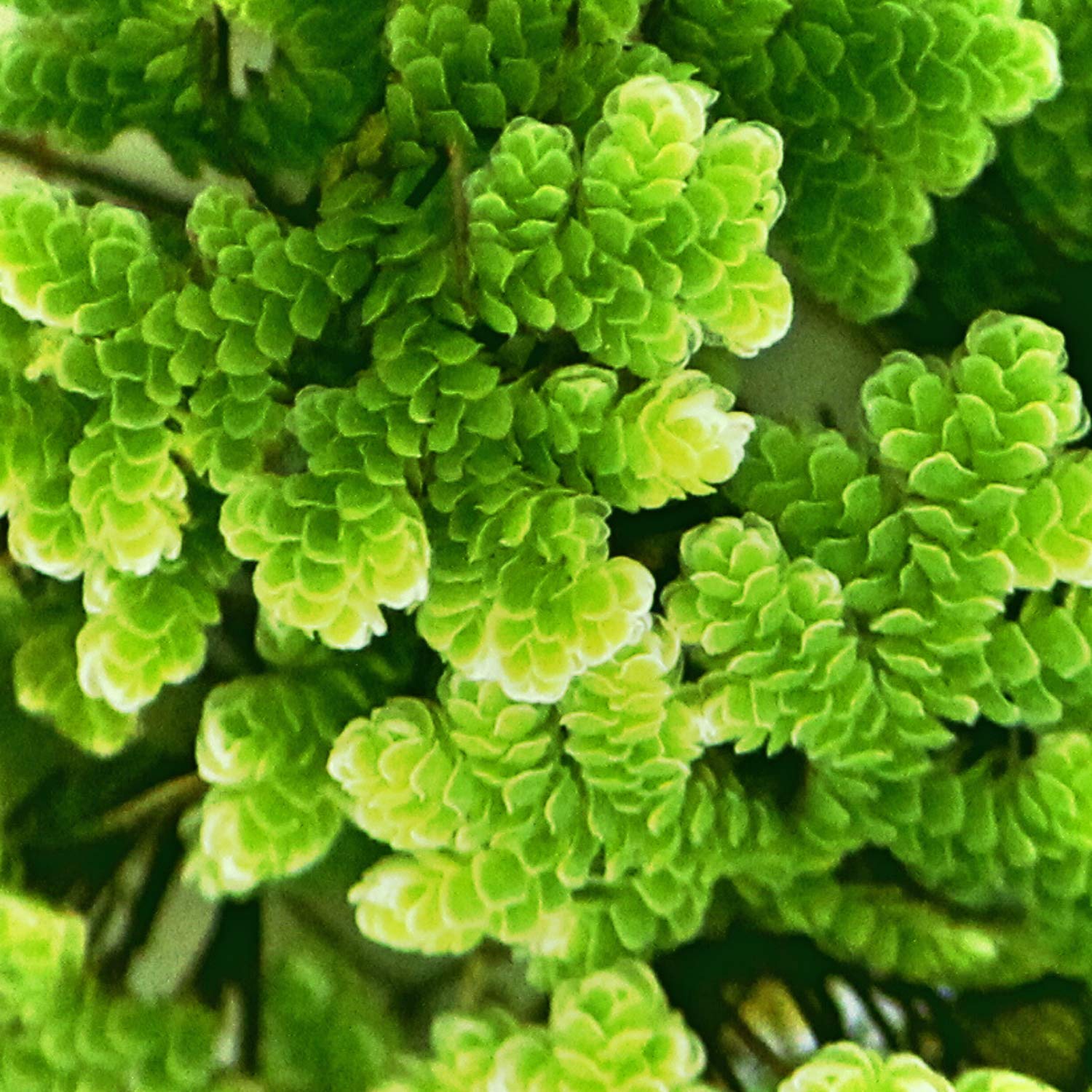 |
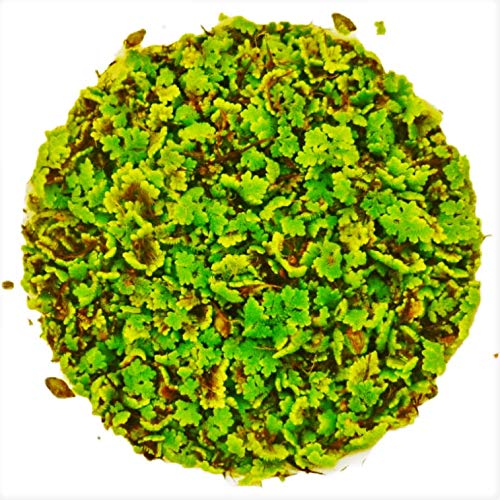 |
Read More: Is Silage a Complete Feed for Medium Milk-yielding Cows?
Dr. Rajesh Kumar Singh,
Mo:9431309542,
